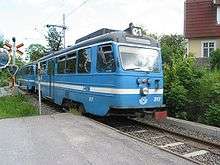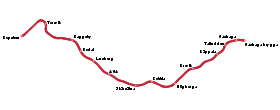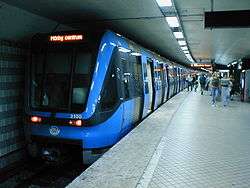Lidingöbanan
| Lidingöbanan | |||
|---|---|---|---|
 Train of A30B and B30B tram cars at Kottla | |||
| Overview | |||
| Type | Light rail/Tram | ||
| System | Storstockholms Lokaltrafik | ||
| Status | Active | ||
| Locale | Lidingö | ||
| Termini |
Ropsten Gåshaga brygga | ||
| Stations | 13 | ||
| Services | 1 | ||
| Operation | |||
| Opened | 1914 | ||
| Operator(s) | AB Stockholms Spårvägar | ||
| Depot(s) | AGA | ||
| Technical | |||
| Line length | 9.2 km (5.72 mi) | ||
| Track length | 9.2 km (5.72 mi) | ||
| Track gauge | 1,435 mm (4 ft 8 1⁄2 in) standard gauge | ||
| Route number | L21 | ||
| |||
| Lidingöbanan | ||||||||||||||||||||||||||||||||||||||||||||||||||||||||||||||||||
|---|---|---|---|---|---|---|---|---|---|---|---|---|---|---|---|---|---|---|---|---|---|---|---|---|---|---|---|---|---|---|---|---|---|---|---|---|---|---|---|---|---|---|---|---|---|---|---|---|---|---|---|---|---|---|---|---|---|---|---|---|---|---|---|---|---|---|
Legend
| ||||||||||||||||||||||||||||||||||||||||||||||||||||||||||||||||||
Lidingöbanan ("The Lidingö Line") is a light rail in Stockholm, Sweden, between Ropsten and Gåshaga brygga, serving the southern half of Lidingö island.
The Lidingöbanan has its origins in the Stockholm-Södra Lidingöns Järnväg (Stockholm-Southern Lidingö Railway), proposed by inventor Gustaf Dalén. Public transportation on Lidingöbanan has always been provided using tram cars, but in the past Lidingöbanan also carried goods traffic. At its largest, Lidingöbanan extended to Humlegården in Stockholm through Stockholms Spårvägar's tramway network, with access to the Värtabanan railway track. There was also traffic on a track on the north side of Lidingö island which terminated at Kyrkviken, but that section closed in 1971. Lidingö town centre is now accessible only by bus. Lidingöbanan formally became part of SL's public transportation network in 1972.
Lidingöbanan was legally a railway until August 2008, when it was reclassified by the Swedish railway inspectorate (Järnvägsstyrelsen). Passenger service has, however, always been provided by tramcars, which prior to 1967 continued onto the streets of Stockholm, as mentioned above. The electrical infrastructure (overhead wire) is of tram type.
Until recently the rolling stock consisted of Type A30/A30B and B30/B30B maneouver trams, all over fifty years old, and dating from the period (1940s–50s) when the Stockholm Metro was only partially completed and these areas were served by trams, adapted for faster two-way traffic.
Lidingöbanan has been closed since summer 2013 for engineering works, modernisation and installation of new equipment. The track will be replaced (with some lengths of single track converted to double) and new Type A36 trams and signalling introduced. The Lidingöbanan reopened in October 2015[1] after a construction period of 2,5 years with rail replacement buses running during this period.
Lines
Lidingöbanan has a single line with thirteen stations, from Ropsten in northeast Stockholm to Gåshaga brygga in southeastern Lidingö. At Ropsten there is an interchange with the Stockholm Metro Red Line 13, and a Waxholmsbolaget archipelago boat terminal at Gåshaga brygga.
There are plans to connect the line with the Spårväg City line in central Stockholm in 2020.
| Line | Stretch | Length | Stops |
|---|---|---|---|
| 21 | Ropsten – Gåshaga brygga | 9.2 km | 13 |
See also
References
- ↑ SVT (2015-10-23). "Lidingöbanan öppnar igen efter 2,5 år; Oct 23th 2015". SVT.se. Retrieved 2016-03-21.
External links
- 2012 Map of all SL Rail Lines (tram lines included) (pdf)
- Storstockholms Lokaltrafik (Stockholm Transport) - official site (English)
- Storstockholms Lokaltrafik (Stockholm Transport) - official site (Swedish)
- Järnväg.net - Lidingöbanan (Swedish)



